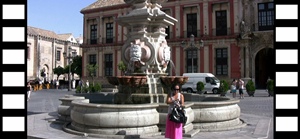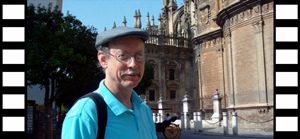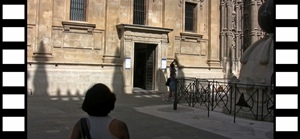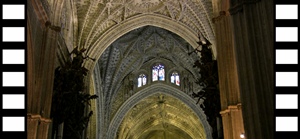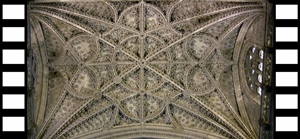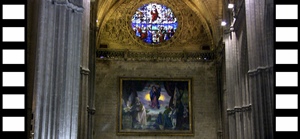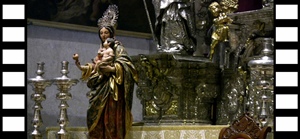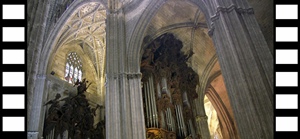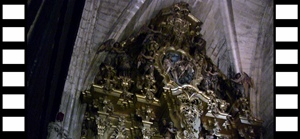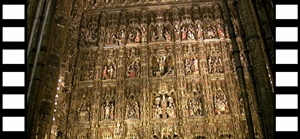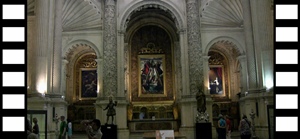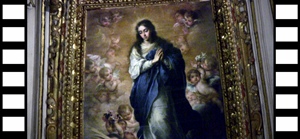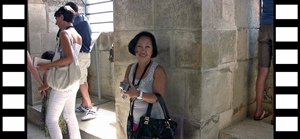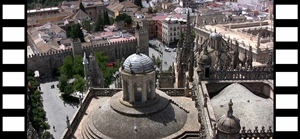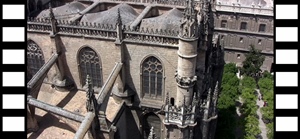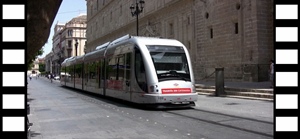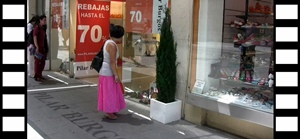When the Moors were evicted from Seville in 1248, they left behind a gigantic
mosque, along with a minaret from which the faithful were called to prayer. The
mosque was relatively new, having been completed in 1198, and Seville's conqueror,
Ferdinand III, had it converted to Christian uses, having it consecrated as a
cathedral. This worked out fine until 1356, when the cathedral was damaged by an
earthquake. In 1395 another earthquake hit, and the cathedral's canons started
thinking in terms of replacing the building. In 1401 it was decided to tear down
the former mosque and build a new cathedral of a scale which would convince
posterity that the canons had taken leave of their senses. Construction proceeded
over the next century, and the new cathedral was consecrated in 1507. Between 1558
and 1568 a top was added to the former minaret, called the Giralda,
transforming it into a bell tower and bringing its height to 344 feet.
The Giralda
The Seville Cathedral (formally
called the Cathedral of St. Mary of the See) is billed as the largest cathedral
in Christendom. It's not the largest in floor area, trailing St. Peter's
Basilica in Rome and St. Paul's Cathedral in London in this statistic. But it
could hold more ping pong balls than either of them due to its high ceiling
(134 feet in the central nave, 96 feet in the aisles), a fact verified by the
Guinness Book of World Records on a posted certificate.

Old Town Area

Cathedral Neighborhood
To get to the Cathedral we headed for the Giralda, the part of the Cathedral most
easily seen from a distance (though with all the narrow streets, it's hard to see
anything from a distance). This approach deposited us in the Plaza Virgen de los
Reyes, on the east side of the church and at the foot of the bell tower.

Nella, Fountain and Giralda

Nella, Fountain and Giralda

Bob and Cathedral

Apse Exterior, Capilla Real
Though there was a door on this side of the church, like all of the other
elaborate Cathedral doors it was not accessible.

Puerta del Baptismo (Door of the Baptism)

Portada de la Asunción (Door of the Assumption)
Puerta del Perdon (Door of the Forgiveness)
We found the entrance on the south side of the church, off the Plaza del
Triunfo (named to celebrate the triumph of the city over an earthquake in
1755). On this side of the Cathedral is found a door called The Prince's
Doorway, as well as a copy of the weathervane on top of the Giralda (the
figure represents Faith, and this copy is most likely the original, kept in a
sheltered area for its protection). But the entrance is through a much less
grandiose door on the left.

Portada del Príncipe (Door of the Prince)

Above Portada del Príncipe

Faith Figure

Portada del Príncipe and Faith Figure
We entered the door, paid our seven-Euro entrance fee and followed the passageway
into the church.
The inside of the Cathedral was dimly lit and cavernous. We found ourselves near
the back right corner of the church and immediately began to explore. There was
a central nave with two parallel aisles on each side, and a very high ceiling, as
advertised.

Interior

Stained Glass Window

Altar of the Trascoro and Vaulting

Altar of the Trascoro (1619-35)

Carvings Outside Choir

Organ
Transept Ceiling and Altar de Plata

Altar de Plata and Wall Decorations

Altar de Plata

Virgen de la Granada and Altar de Plata

Vaulting and Stained Glass

Choir Exterior

Organ in Choir
In our explorations on the right side of the church we discovered the tomb of
Christopher Columbus. People have been skeptical about whether the remains in
the tomb are actually those of Columbus, and the adventures of Columbus's
remains over the centuries certainly make such doubts understandable. Columbus
died in Spain (apparently of a heart attack) in 1506, and he was initially
buried in the town of Valladolid. In 1542 he was dug up and shipped to Santo
Domingo in the present-day Dominican Republic, where he rested in peace until
1795. At this point France was taking over the island of Hispaniola, so
Columbus was again relocated, this time to Havana, Cuba. Cuba became
independent in 1898 as a result of the Spanish-American War, and this
triggered another move, this time back to Spain and the Seville Cathedral. But
in 1877 a lead box was discovered back in Santo Domingo with Columbus's name
on it, containing some bone fragments. This led to a controversy that wasn't
settled until 2003, when DNA samples were taken from the remains in Seville
and compared to those known to belong to his sons. The DNA wasn't in great
shape, but the similarity was apparently enough to pronounce Columbus's
remains to be some portion of Christopher Columbus. The question of the lead
box in Santo Domingo remains a mystery at this point.

Tomb of Christopher Columbus

Bob and Columbus Tomb
Mural of St. Christopher, Pérez de Alesio (1584)
As one would expect for such a large church, there are chapels aplenty,
80 to be exact. Here are highlights from a few:

Chapel of San Laureano

Chapel of San Laureano

Chapel of San Isidoro

Figures, Chapel of San Isidoro

Chapel of San Hermenegildo

Chapel of San Hermenegildo

Tomb of Juan de Cervantes

Chapel of the Virgen de la Antigua
But the most impressive chapel is undoubtedly the Capilla Mayor in the
middle of the church, which contains the Retablo Mayor, the largest
altarpiece in the world (66 ft. X 59 ft.), designed by Flemish artist Pierre
Dancart beginning in 1482 and finally completed in 1564.

Capilla Mayor

Retablo Mayor
Retablo Mayor

Detail, Retablo Mayor

Detail, Retablo Mayor
There is also an extensive Treasury (on the right side of the church, forward
of the Columbus tomb) filled with valuable objects and works of art.

Monstrance, Juan de Arfe (1580-87)

St. Rosalía, Antonino Lorenzo Castelli (1681)

Main Sacristy

Statue of the Virgin, Alonso Martínez

The Descent, Pedro de Campaña (1548)

Statue of St. Ferdinand, Roldán

Alfonsine Tables (13th C.)

Bust of a Bishop

Altarpiece, Campaña and Afián (16th C.)

Monstrance

Cross (1530)

Crown of the Virgen de los Reyes

Chapterhouse

Immaculada, Bartolomé Esteban Murillo (1668)
Chapterhouse
Outside the south Cathedral door is a large courtyard filled with orange trees,
the Patio de los Naranjos. This area dates back to the time of the mosque
that preceded the Cathedral. The fountain was used by the Muslim worshippers to
wash their hands and feet before their prayers. The oranges, like those on trees
growing throughout the city, are inedibly bitter.

Cathedral Spires

Puerta de la Concepción
Nella, Patio de los Naranjos
Reachable from inside the Cathedral is the Giralda, which can be climbed up
to where the bells are. This is done using a spiral ramp, which was used
instead of stairs to enable men to climb the tower while sitting on their
horses. The climb rewards the climber with spectacular views of the
Cathedral and of Seville.

Spire During Ascent

Spires

Patio de los Naranjos and North Wall

Spires

Dome and Spires

Top of Lantern

Nella and Bells

Bell

Bell Mechanism

Guadalquivir River, Hotel Alfonso XIII

Cathedral and Archivo de Indias

Guadalquivir, Alcazar, Archivo de Indias

The Alcazar

Seville and Cathedral Roof
Bullring and Triana Bridge
After descending from the Giralda we exited the Cathedral and window-shopped at
the stores across from the west side of the church. We also found that a
modern-looking tram travels along this side of the church.
Cathedral from Ground

Cathedral and Tram

Nella Window Shopping
We walked southward along Avenida de la Constitucion in search of food.
We found a restaurant that looked good across from the luxurious Hotel Alfonso
XIII. And just in time, as I was starting to wilt from the heat.
Hotel Alfonso XIII
After cooling off and refueling we set off for our next destination, the
Royal Alcazar of Seville.





